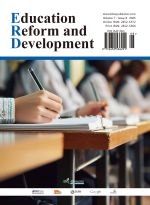Abstract
This study examines the pedagogical effectiveness of a blended learning approach integrated with the BOPPPS (Bridge-in, Objective, Pre-assessment, Participatory Learning, Post-assessment, Summary) instructional model, situated within the context of advancing artificial intelligence and data science education. Using the course ‘big data statistical analysis’ as a case study, we compare traditional lecture-based instruction with the “BL+BOPPPS” framework to evaluate its impact on online and offline learning outcomes. Our implementation of the “BL+BOPPPS” model demonstrates its effectiveness in fostering student autonomy, enhancing critical thinking skills, and cultivating innovation capabilities. Furthermore, this study contributes to the theoretical foundation for teaching big data statistical analysis, offering evidence-based insights to optimize instructional effectiveness in this discipline.
References
Lu Q, Song L, Yu K, 2022, The Effects of Operational and Digitalization Capabilities on SMSs’ Supply Chain Financing under Supply Risk. International Journal of Logistics Research and Applications, 26: 1642–1662.
Yang J, Liu J, Yao Z, et al., 2024, Measuring Digitalization Capabilities Using Machine Learning. Research in International Business and Finance, 70: 102380.
Lenkas P, Paridav W, Wincent J, 2017, Digitalization Capabilities as Enablers of Value Co-Creation in Servitizing Firms. Psychology and Marketing, 34(1): 92–100.
Ji J, 2024, Application of Big Data Statistical Analysis Methods in the Field of Economic Management. International Journal of Global Economics and Management, 4(2): 1–6.
Chen M, Du Q, 2021, E-Commerce Marketing Strategy Based on Big Data Statistical Analysis. 13th International Conference on Measuring Technology and Mechatronics Automation, 686–689.
Liu M, Zhu Y, Li L, 2021, Exploration and Effect Evaluation of Teaching Reform of Big Data Course Oriented by Professional Application. IEEE 3rd International Conference on Computer Science and Educational Informatization, 127–134.
Zhang M, Kang Z, Zhang Z, 2022, Curriculum Reform and Practical Application under the Background of Information Technology and Big Data—Take the Course of “Multivariate Statistical Analysis” as an Example. Journal of Applied Mathematics and Computation, 6(3): 370–374.
Lima Guedes K, Davis H, Schulz J, 2022, Integrating MOOCs into Traditional Higher Education Modules: A MOOC-Based Blend Framework. Research in Learning Technology, 30: 2702.
Hao H, Chen W, 2025, Research on the Application Effect of BOPPPS and ChatGPT-Based AI-Assisted Teaching in the Machine Learning Course. The Asia-Pacific Education Researcher, 1–12.
Garrison D, 2011, E-Learning in the 21st Century: A Framework for Research and Practice, 2nd ed. Routledge, New York.
Garrison D, Kanuka H, 2004, Blended Learning: Uncovering Its Transformative Potential in Higher Education. Internet and Higher Education, 7: 95–105.
Staker H, Horn M, 2012, Classifying K-12 Blended Learning. Innosight Institute, 1–20.
Picciano A, 2009, Blending with Purpose: The Multimodal Model. Journal of Asynchronous Learning Networks, 13(1): 7–18.
Graham C, Robison R, 2007, Realizing the Transformational Potential of Blended Learning: Comparing Cases of Transforming Blends and Enhancing Blends in Higher Education. In: Picciano AG, Dzuiban C (eds), Blended Learning: Research Perspectives. The Sloan Consortium, Needham, 83–110.
Instructional Skills Workshop Network, ISW Handbook, visited on August 1, 2025, https://www.iswnetwork.ca/resources/isw-and-fdw-handbooks/.
Kang H, Ma R, Ma C, et al., 2022, Comparison of the BOPPPS Model and Traditional Instructional Approaches in Thoracic Surgery Education. BMC Medical Education, 22: 447.
Niu Z, Lou L, 2017, Application of BOPPPS Teaching Model in Adult Education Teaching Design. China Adult Education, 16: 97–99.
Su D, Zou L, Wang L, et al., 2024, Student Engagement and Teaching Presence in Blended Learning and Emergency Remote Teaching. Journal of Computers in Education, 11(2): 445–470.
Ma X, Ma X, Li L, et al., 2021, Effect of Blended Learning with BOPPPS Model on Chinese Student Outcomes and Perceptions in an Introduction Course of Health Services Management. Advances in Physiology Education, 45(2): 409–417.
Angelos C, Rangoussi M, Koulouriotis D, 2022, Blending E-Learning with Hands-on Laboratory Instruction in Engineering Education: An Experimental Study on Early Prediction of Student Performance and Behavior. International Journal of Emerging Technologies in Learning, 17: 213–230.
Shi J, Yang Y, 2024, Design and Practice of Blended Teaching Mode Based on BOPPPS: Taking the Course “Management Information Systems” as an Example. Higher Education and Practice, 467–473.
